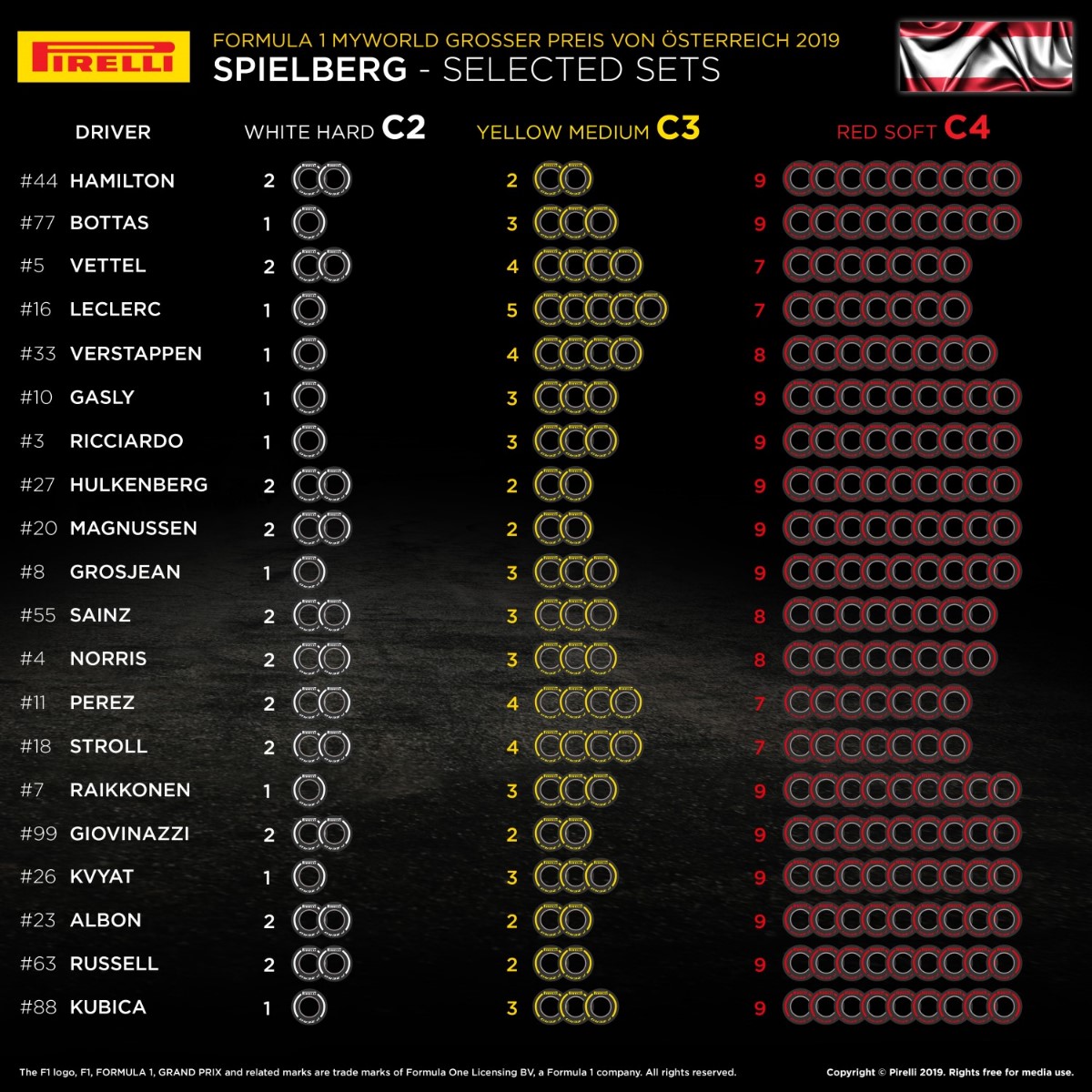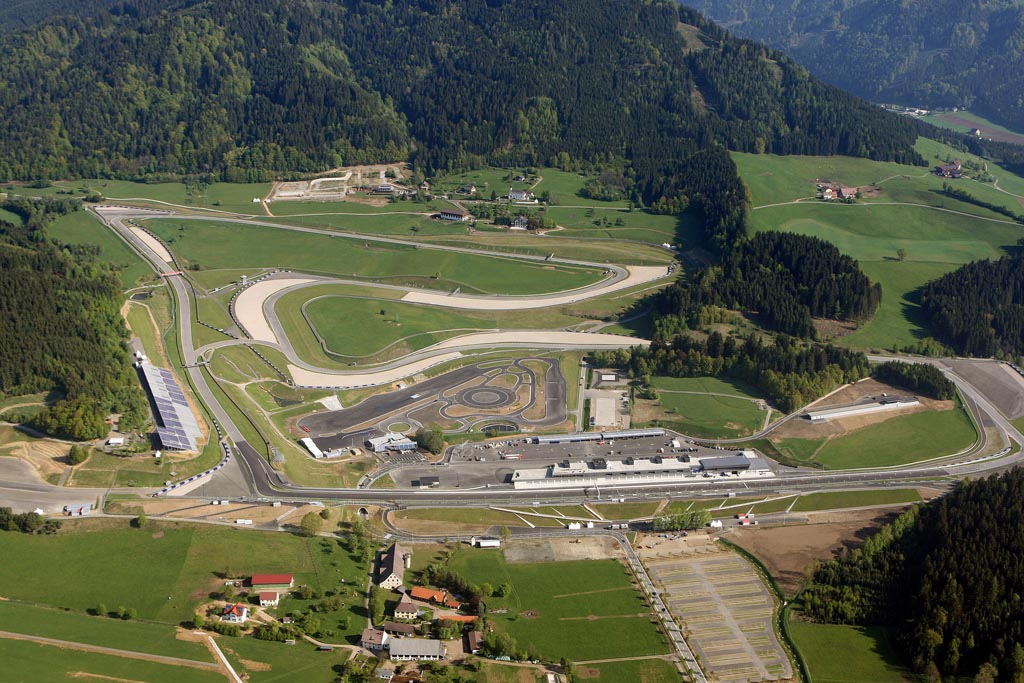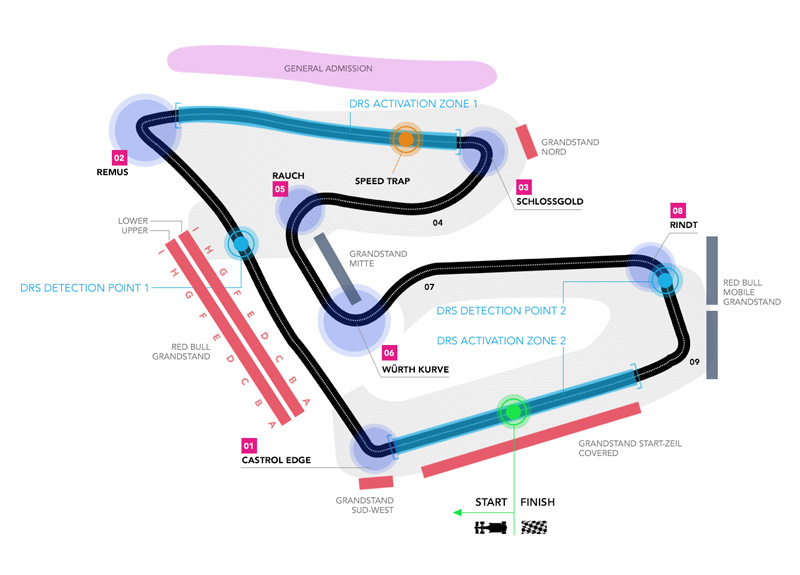Austrian GP Preview
 |
| The Red Bull Ring is in a beautiful setting |
The Styrian Mountains provide a fitting backdrop for Rich Energy Haas F1 Team as it embarks upon the Red Bull Ring in Spielberg, Austria for Sunday’s Austrian Grand Prix at the 4.318-kilometer (2.683-mile), 10-turn Red Bull Ring. The young American team continues to look upward in the Formula One standings at a venue that has proved to be a happy hunting ground in the past.
Last season’s Austrian Grand Prix saw Rich Energy Haas F1 Team earn its best collective result to date, with Romain Grosjean finishing fourth and teammate Kevin Magnussen right behind him in fifth. It was the squad’s 50th grand prix and the superb finish came at the site of the last Formula One victory by an American team. It was 1976 when Irishman John Watson drove a Penske PC4 to the win over the Ligier of France’s Jacques Laffite with a convincing 10.79-second margin of victory.
While a win by anyone other than Mercedes, Scuderia Ferrari and Red Bull still seems distant – with Kimi Räikkönen’s Australian Grand Prix victory for Lotus in 2013 the last win by a team other than the big three – the points haul that comes with a best-of-the rest finish remains strong. Rich Energy Haas F1 Team scored 22 points in last year’s Austrian Grand Prix, bumping it up to fifth in the constructors’ standings.
[adinserter name="GOOGLE AD"]Currently, the fourth-year team is ninth in the constructors’ ranks with 16 points, one behind eighth-place Toro Rosso yet still a manageable 16 points away from fifth-place Renault. It’s a deficit that another potential, double-points finish in Austria can erase.
The 4.318-kilometer (2.683-mile), 10-turn Red Bull Ring has suited Rich Energy Haas F1 Team well since the team’s debut in 2016. Grosjean has three straight top-10 finishes and has improved his result each year, as he came home seventh in 2016, sixth in 2017 and, of course, fourth in 2018. Magnussen has two top-10s in four career starts at the track. He finished seventh in his first Formula One race at the Red Bull Ring and fifth in last year’s race.
With only three point-paying finishes in the eight races run so far this season, Austria can provide welcome reprieve for Rich Energy Haas F1 Team. History, after all, is on its side.
Tires Selected

Guenther Steiner
 |
| Red Bull Ring |
How helpful is it to have back-to-back grands prix where the same tire compounds are being used? More specifically, is there carryover in tire data between France and Austria since the tires are the same?
“There should be something, but with the struggles we have with the tires this year, I would not jump to the conclusion to say we can take the data we get from France and take it to Austria. The Austrian track is a different layout and the tarmac roughness is different."
Does the Red Bull Ring’s quick yet compact layout lend itself to getting the tires into their proper operating window and, just as importantly, keeping them in that window?
“I don’t think any more about the tires – if they work or not, I always wait for Fridays. Then I get a little bit closer to knowing what they’re doing, but we have no confidence in saying when and where they’ll work on our car."
Rich Energy Haas F1 Team earned its best collective result in last year’s Austrian Grand Prix when Grosjean finished fourth and Magnussen finished fifth. It was more than a best-of-the-rest result as the team was just one position shy of the podium. How was that result achieved?
“When you’ve got a good car and you find the right setup, it’s pretty easy to do. There were a few retirements in the race from the big three teams in front of us and we finished as we did. Once you’ve done it, it seems to be easy. But to get there, it’s very difficult. I don’t know if we can achieve it this year, but for sure we’ll be trying."
The collective decision was made by the Formula One industry to delay the presentation of the 2021 rules package until October. Why was this necessary, and how does it impact a smaller outfit like Rich Energy Haas F1 Team compared to the bigger teams?
“In general, it’s better. We keep the same governance to define the details of the regulations, as we have now. If it would be announced now, the international sporting code would be the governance and the teams would have no say in it. The FIA, Liberty and the teams agreed for it to be extended. We collaborated together to finalize the regulations. The big teams will always have an advantage over the smaller ones when something new comes. I don’t think there will be a big difference by delaying it to October. We just need to do our best, as we always try to do. We will aim to get to a point in 2021 where we have a good car with those regulations."
The 1976 Austrian Grand Prix at the previously named Osterreichring is the site of the last Formula One victory by an American team. Despite the current draft of the 2021 regulations being somewhat green, do they provide hope that teams like Rich Energy Haas F1 Team can contend for wins by establishing a more level playing field?
“I think in 2021 we’ll be another step closer, but we will not be there yet. The budget cap is still high for us, but it’s low for the big teams. We need to be fair. The big teams cannot go down to a very small budget within a very short period of time. That wouldn’t be correct for their employees. So, it will take some time for the playing field to really be level. Hopefully, it will bring the field together a little bit more."
Romain Grosjean
How helpful is it to have back-to-back grands prix where the same tire compounds are being used? More specifically, is there carryover in tire data between France and Austria since the tires are the same?
“Yes, I think so. It’s always good to have consistency in what we use. It will help us to use the previous findings into the next week. When we change that lineup, it’s a bit harder."
Does the Red Bull Ring’s quick yet compact layout lend itself to getting the tires into their proper operating window and, just as importantly, keeping them in that window?
“I won’t say too much. So far things haven’t been amazing, so let’s find out when we go there."
You come into the Red Bull Ring with three straight top-10 finishes in the Austrian Grand Prix, specifically, fourth last year, sixth in 2017 and seventh in 2016. While past performances aren’t always indicative of how you’ll perform in this year’s car, does it at least provide a mental advantage in that you know what you need out of the car to be successful in Austria?
“I’ve always enjoyed the Austrian Grand Prix. I’ve always had a good feeling there. I’m looking forward to going back there. I’m hoping the car’s going to work well. It’s a great place with a great atmosphere during the weekend. I’m hoping we can get back in the points."
 |
| Track Map |
Rich Energy Haas F1 Team earned its best collective result in last year’s Austrian Grand Prix when you finished fourth and Magnussen finished fifth. It was more than a best-of-the-rest result as you were just one position shy of the podium, and it remains your best finish with the team. How was that result achieved?
“Last year in Austria we were fast from the first timed lap in free practice. The car felt really good over the whole weekend. We even managed to beat a Red Bull in qualifying, which was quite incredible. In the race we were best of the rest, then got a bit lucky with a few cars retiring in front of us. We took advantage of that. It was a good weekend and the car worked really well right from the start, which always makes your life a lot easier."
Your teammate describes the Red Bull Ring as a short, roller-coaster ride. How do you describe it and how are you able to generate such high speeds on such a compact track?
“I agree with Kevin’s comments. It’s a very tight, tiny lap – just a minute and four seconds or so. It gives you a good feeling. It’s up and down with good corners. I’ve always enjoyed driving there a lot."
Kevin Magnussen
How helpful is it to have back-to-back grands prix where the same tire compounds are being used? More specifically, is there carryover in tire data between France and Austria since the tires are the same?
“I guess there will be a little bit of a carryover, but the tracks are slightly different, even though we’re using the same tires. It’s not like we can carry over everything."
Does the Red Bull Ring’s quick yet compact layout lend itself to getting the tires into their proper operating window and, just as importantly, keeping them in that window?
“I don’t think we can say we understand the full picture yet. We’re very much taking each race as it comes and trying to get the best out of each opportunity."
Rich Energy Haas F1 Team earned its best collective result in last year’s Austrian Grand Prix when Grosjean finished fourth and you finished fifth. It was more than a best-of-the-rest result, as the team was just one position shy of the podium. How was that result achieved?
“We were strong in the Austrian Grand Prix – stronger than the rest of the midfield. We were actually pretty close to matching Red Bull, in qualifying at least. In the race, Red Bull had a lot more pace than us, but then both Mercedes failed to finish, so you need a bit of luck, as well. We had a perfect weekend from a team performance perspective."
You’ve described the Red Bull Ring as a short, roller-coaster ride. Despite its relatively short length, you’re able to generate some significant speed. Is the Red Bull Ring kind of your ideal track, where you can push the limits time after time in search of more and more speed?
“The Red Bull Ring is a good little circuit. It’s a little bit unique. It’s a very small area. It kind of reminds me of a go-kart track in that you can basically see the whole track from the grandstands. It’s quite nice and compact, but still with some fast corners and long straights, giving some opportunities to overtake. When I’ve raced there, it’s been entertaining. It’s a fun little track."
Your father, Jan, has made 21 starts in the 24 Hours of Le Mans, the most recent of which took place less than two weeks ago. How often do you talk to him about the race and the appeal of Le Mans?
“We talk about Le Mans a lot. It’s obviously his job at the moment, and has been for the last 21 years. It’s basically been a part of my life, as my dad has been racing there for so long. I’ve always followed it closely for that reason, of course. I’ve grown a passion for Le Mans, as well. It’s a dream of ours to do Le Mans together, and to do it in a competitive way."
Mercedes Toto Wolff talks Austria
Our result in last year's Austrian Grand Prix was the low point of the 2018 season. A double DNF after a promising front-row lockout meant that we left a lot of points on the table. The race was a cruel reminder how quickly things can go wrong in our sport and that reliability and performance go hand in hand in Formula One.
This year, our race finishing record has been good, but it would be complacent to ignore the fact that for two weekends in a row now, our mechanics had to perform the equivalent of "open-heart surgery" on our cars. We've faced a number of different issues on different components, each of which could have easily caused us to retire, so we need to get on top of those challenges as quickly as possible.
The forecast for Austria predicts temperatures of 30 degrees Celsius and more – combined with the reduced air density owing to the track's location at altitude, this means that cooling could become a real challenge in Spielberg. Add to that the short lap and the close gaps on that circuit and our direction is clear: we need to keep working diligently, stay humble and give it everything to do a better job than we managed 12 months ago.
Racing Point's Lance Stroll
Lance: “Racing in Austria is good fun. The lap is fast and compact, and it’s very enjoyable to drive. It’s a track where I raced a lot during the junior categories and it’s always feels very familiar to me when we go back there.
“When you look at a circuit map, it appears to be a short and simple lap, but the reality is quite different. All of the corners are a challenge and there are some big stops where you have to be really precise and confident on the brakes. If you go in a bit deep and miss the apex, it will really hurt your lap time. So the biggest challenge is getting together the perfect lap, even though there are only ten corners."
“As a venue it’s got to be one of the most beautiful places we visit. It’s really in the middle of the countryside and quite isolated. The track follows the flow of the hills and there’s some nice elevation changes – such as the approaches to turns one and two."
Racing Point's Sergio Perez
Sergio: “Going to Austria feels like racing in nature. You’re driving an F1 car through the hills and it’s such a beautiful place. I enjoy the Austrian food as well: it’s some of the best of the year.
“It’s a fun little track because it’s quite short with only a few corners and the grid is always really tight. Every tenth really does make a big difference to your qualifying position.
“I’ve had some good results in Austria over the years, but my favorite memory is the 2014 race where I did a very long first stint and lead the race for quite a few laps. That was the first year we returned to Austria and it was a really busy weekend with so many fans.
“Even though it’s a short lap, there are some interesting corners. The best section for me is turns nine and ten – the last part of the lap – because they are really quick and you have to be committed. The track drops away too so it’s easy to run wide. When you hit the apex just right, it feels very satisfying."
